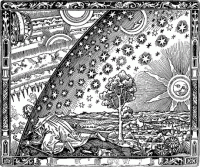Beyond the Edge of the Curriculum Map
In 2013, sandbox video games have changed gaming more than a little. Players can now define their own terms for success, and the evolution of certain gamification elements makes this more than a fantasy in the minds of the players. There really are multiple measures of success.
In fact, there are games today that have no endgame at all. There may be a finishing sequence to the narrative -- some final quest fulfilled or objective accomplished -- but even then there’s oodles more gameworld to explore: character journals to read, side-quests to complete, missions to replay so that you can refine your performance . . .
It's never really over, and rather than being maddening, this is indicative of a trend seemingly encouraged by the digital universe into which we all duck our heads each day.
The same difference between a magazine and a blog rests between old video games and new video games. A blog is never finished. By definition it surveys, explores and publishes in a constant churning motion. If it doesn't self-improve, it will age and fade away.
Even blog posts themselves can be constantly updated, endlessly fluid documents that are revised, linked to, dug up by dutiful Google bots, shared, and ultimately curated -- hung in some Pinterest hall of fame. And on the surface, this constant motion is also true in learning. But if we look a bit more closely, we can see this isn't always the case.
In planned learning experiences, there is a beginning and an end, and rather than an entirely logical reality dictated by the nature of school, it could be a problem.
Activity>Lesson>Unit
The structure of formal learning in most classrooms is a basic sequence of activity>lesson>unit, with a culminating assessment of some sort. Whether this assessment is a performance, a project or a traditional multiple-choice and short response exam, its function is the same: to evaluate understanding of a given set of standards.
These standards were often planned ahead of time -- probably in some form of curriculum map or scope and sequence that allows teachers to roughly sketch out what will be taught when. This both ensures coverage of standards and provides a path or "map" so that all teachers can be on the same page. In theory, curriculum maps are wonderful and among the best school improvement tools you can use. They are the proving grounds for all of the theory and rhetoric, the place where you hold yourself and students accountable by making a clear plan to accomplish all that you hope to by year's end.
But in practice, curriculum maps are almost always not the "living, breathing" documents that experts like Heidi Jacobs Hayes promote. They are instead very dead things -- lifeless prisons of content to be covered, and boxes to be highlighted in Data Team and Professional Learning Community meetings. For a curriculum map or any planned learning experience to be vital -- and vitally useful -- it must be adaptive and circular rather than rigid and linear. It must by design be able to respond to the performance of the students.
And more critically, this planned learning experience must encourage students to continue their pursuit of understanding and self-knowledge.
By design, curriculum maps must always offer students something more and room to roam, and give only hints of closure where it is necessary. Finishing a novel or a poem is a bit of an illusion, isn't it? By learning through iteration, by seeking the persistent motion of practice and revision, we can more honestly follow the pattern of the real world, where there is no stopping point, or even a reason to stop doing things that are worth doing.
Rather, we live and learn by the human process of daily mending.
